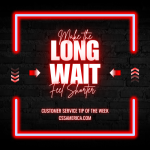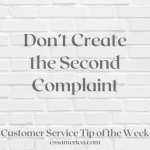
The restaurant always did something a little special. It was the free dessert, the personalized menu, the visit from the manager, an appetizer that was compliments of the chef, or the upgrade to a nicer table.
Every time it was a WOW to the customer. We define a “WOW” moment as an “Unexpected Positive Event.” And while these WOWs may be obvious for a restaurant, many of us don’t work in restaurants. We work at events, at colleges, at hospitals, and at banks. We work in government, in manufacturing, in clinics, and in sports.
Does this mean the WOW’s not possible? No, it just means that the WOW sometimes isn’t a financial expenditure, but it’s still possible. Zappos strives to give each customer a WOW moment. Surely they don’t spend $10 per customer to WOW them.
So what UPE can you create for your customer that costs virtually nothing? Put your twist on some of these ideas:
- Stand up when they approach your desk (this RARELY happens nowadays).
- Convey sincere excitement when they walk in the door (how happy do the people at the vet seem when you bring in your kitten for an exam?).
- Come out of your office to greet the customer (it makes them feel important)
- Respond to voice mails and e-mail messages as soon as they’re received, particularly if there’s an issue (speed is vital in Service Recovery).
- Provide them some “educational” information that enables them to have a better experience in working with your organization (it’s not just about reacting to their need; it’s also about being proactive and helpful).
- Call somebody by name throughout the discussion (it makes them feel that they matter to you).
- Sincerely thank them for their business – noting that you really appreciate their being your customer (be patient in the close).
- Send them a handwritten “Thank You” note after the encounter (another RARE activity nowadays).
- Call them after an appointment to check-in, gauge their experience, or ask if they’re enjoying the use of the product (WOW with the follow-up).
Think of the little things that are UNEXPECTED but so good that they make the customer remember you positively.
Think of something that brands your encounter as a “WOW!”























